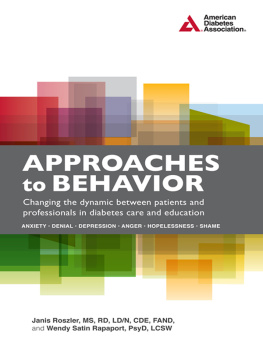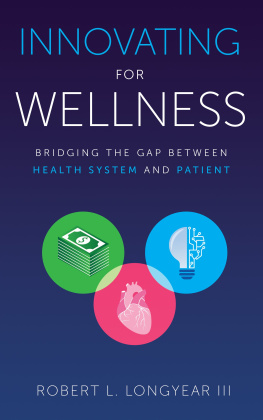APPROACHES to BEHAVIOR
Changing the dynamic between patients and professionals in diabetes care and education
Janis Roszler, MS, RD, LD/N, CDE, FAND, and Wendy Satin Rapaport, PsyD, LCSW
Director, Book Publishing, Abe Ogden; Managing Editor, Greg Guthrie; Acquisitions Editor, Victor Van Beuren; Production Manager, Melissa Sprott; Production Services, Cenveo Publisher Services; Cover Design, Kim Woody.
2015 by the American Diabetes Association, Inc. All Rights Reserved. No part of this publication may be reproduced or transmitted in any form or by any means, electronic or mechanical, including duplication, recording, or any information storage and retrieval system, without the prior written permission of the American Diabetes Association.
Printed in the United States of America
1 3 5 7 9 10 8 6 4 2
The suggestions and information contained in this publication are generally consistent with the Clinical Practice Recommendations and other policies of the American Diabetes Association, but they do not represent the policy or position of the Association or any of its boards or committees. Reasonable steps have been taken to ensure the accuracy of the information presented. However, the American Diabetes Association cannot ensure the safety or efficacy of any product or service described in this publication. Individuals are advised to consult a physician or other appropriate health care professional before undertaking any diet or exercise program or taking any medication referred to in this publication. Professionals must use and apply their own professional judgment, experience, and training and should not rely solely on the information contained in this publication before prescribing any diet, exercise, or medication. The American Diabetes Associationits officers, directors, employees, volunteers, and membersassumes no responsibility or liability for personal or other injury, loss, or damage that may result from the suggestions or information in this publication.
 The paper in this publication meets the requirements of the ANSI Standard Z39.48-1992 (permanence of paper).
The paper in this publication meets the requirements of the ANSI Standard Z39.48-1992 (permanence of paper).ADA titles may be purchased for business or promotional use or for special sales. To purchase more than 50 copies of this book at a discount, or for custom editions of this book with your logo, contact the American Diabetes Association at .
American Diabetes Association
1701 North Beauregard Street
Alexandria, Virginia 22311
DOI: 10.2337/9781580405386
Library of Congress Cataloging-in-Publication Data
Roszler, Janis, author.
Approaches to behavior : changing the dynamic between patients and professionals in diabetes care and education / Janis Roszler, Wendy Satin Rapaport.
p. ; cm.
Includes bibliographical references and index.
ISBN 978-1-58040-538-6 (alk. paper)
I. Rapaport, Wendy Satin, 1947- author. II. American Diabetes Association, issuing body. III. Title.
[DNLM: 1. Attitude of Health Personnel. 2. Diabetes Mellitus--therapy. 3. Health Communication. 4. Professional-Family Relations. 5. Professional-Patient Relations. WK 815]
RC660
616.462--dc23
2014008450
eISBN: 978-1-58040-595-9
To the professors who inspired me as a student at UMass Bostons Marriage and Family Therapy program: Drs. Gonzalo Bacigalupe, Alisa Beaver, Esmaeil Mahdavi, MaryAnna Ham, Dawn Shelton, and Margarita Tarragona. Your insightful life lessons transformed how I interact with others. May you continue to inspire your students to learn, grow, and reach out to those in need.
Janis Roszler
To my wonderful husband Jim, my soul mate and inspiration, who makes me dig deep to be a better wife to a person who has diabetes.
Wendy Satin Rapaport
Contents
Everyone plays a role in communication
The environment matters
Ways to build communication pathways
Approaches to use with patients
More approaches to use with patients
How you and your patients may feel
Group communication
Workplace communication
Communication with patients and their families
Ways to emotionally transition from work to home
A s a health care professional you have a wealth of knowledge to share. So why dont some of your patients listen, participate, and follow through?
This book examines the emotional noise that makes it more difficult for patients to gain from interactions they have with you, their health care provider. Some of the interference comes from the patients themselves. Living with a chronic disease like diabetes can prompt such feelings as worry, anger, fear, guilt, frustration, and denial that make it harder for patients to learn, collaborate, and make behavioral decisions. Some of the noise may also come from youyour mood, energy level, frustration, and even patience level can accompany you in the conversations you have with patients. So, as you read, we not only will focus on your patients feelings and emotions, but also will discuss yours as well.
This book focuses on evidence-supported strength-based resiliency strategies from family therapy, cognitivebehavioral therapy, emotionally focused therapy, and positive psychology (Norcross, 2002, Hofmann, 2012, Johnson, 2012, Seear, 2013). Many strategies are based on two assumptions: 1) We affect our patients and others in our lives in a bidirectional or circular wayhow we feel and act affects how others respond and vice versa; and 2) it is not possible to fully understand another persons life experience; to gain information about another person, one must respectfully ask questions and not make assumptions.
The guidance we share within this book is not only for those who work with patients who have diabetes. It also is for health care providers who work with individuals who have any challenging medical issue. If you are just beginning your training, read through the entire book first and fill its margins with your personal thoughts. Take a careful look at your own behaviors, both in your work setting and outside of it. Many of the approaches we share can help you communicate more effectively with everyone in your life, not only with your patients and their families but also with loved ones, acquaintances, and colleagues, especially in this era of integrated care. Refer to this book often as you move through your program.











 The paper in this publication meets the requirements of the ANSI Standard Z39.48-1992 (permanence of paper).
The paper in this publication meets the requirements of the ANSI Standard Z39.48-1992 (permanence of paper).